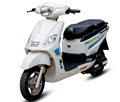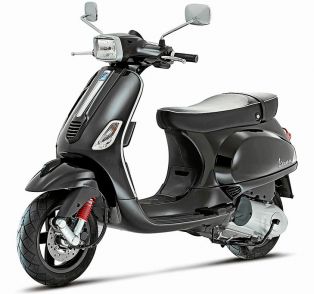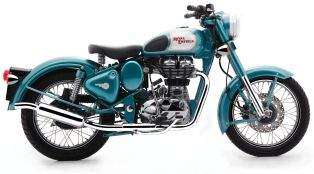We all must have heard terms like shorter gearing and taller gearing. It is all nothing really to do with the height of the gears but it is all about the gear ratios of the bike. The best example here to compare and check are the 200cc twins; the Bajaj Pulsar 200NS and the KTM Duke 200. The former is a taller geared bike while the later is a shorter geared bike. We have seen reviews of both bikes where the KTM is claimed to have insane acceleration while the Pulsar delivers power a lot more linear and nothing too insane.
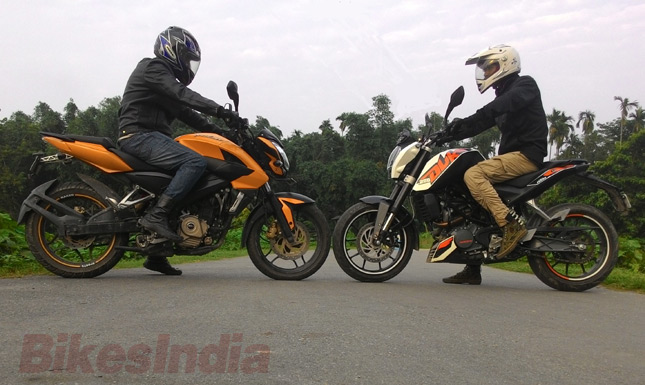 Both are 200cc mills and both share similar technology in the making of the engine. Yes the KTM does have a bit more power owing to the FI setup and a bit higher revving engine, the Pulsar produces a bit less power. Yet both have the same top speed rating. So how this is made possible?
Both are 200cc mills and both share similar technology in the making of the engine. Yes the KTM does have a bit more power owing to the FI setup and a bit higher revving engine, the Pulsar produces a bit less power. Yet both have the same top speed rating. So how this is made possible?
The answer to this question lies in the toothed wheels working their magic on the bikes. Both the front sprocket of the bike connected to the drivetrain in the engine and the rear sprocket on the rear wheel connected via a chain are nothing but gears. These gears have a certain number of teeth on them giving them the tooth rating. So you can find the gears with rating on them such as 15T, 18T, 28T, 36T, 48T, etc. This number actually is nothing much the teeth count on that sprocket.
The smaller front sprocket along with the larger rear forms the entire setup through which the power from the engine is transmitted to the rear wheel. The RPM of the bike also gets decided by this factor. The smaller the front sprocket, the higher the bike’s RPM will be on a certain speed as compared to a bigger front. Confused? Nothing to worry about, everything will be explained in detail ahead, just keep reading.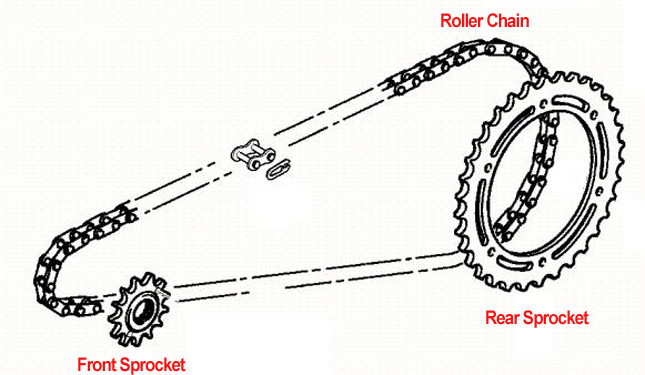 As mentioned before, the teeth number on both the front and rear sprockets have a certain number on them. The number of teeth on the front sprocket to the number of teeth on the rear forms a ratio. So suppose we have a front 15T (i.e. 15 teeth) and the rear as 45T (i.e. 45 teeth), then the ratio between the two is 45/15 = 3.000. This is the ideal ratio to have on paper, but in practical reality this is not always the best way to go.
As mentioned before, the teeth number on both the front and rear sprockets have a certain number on them. The number of teeth on the front sprocket to the number of teeth on the rear forms a ratio. So suppose we have a front 15T (i.e. 15 teeth) and the rear as 45T (i.e. 45 teeth), then the ratio between the two is 45/15 = 3.000. This is the ideal ratio to have on paper, but in practical reality this is not always the best way to go.
This is why the manufacturer plays with the gear ratios to give the bike the optimum power output on the rear wheel as well as match the performance to efficiency factor. This is exactly the reason why the KTM has insane acceleration due to the shorter gearing ratio on the bike; means the ratio of the sprockets on the bike come out to be over 3. On the other hand the ratio on the Pulsar is taller meaning the ratio is below 3. The extra horsepower on the KTM along with the higher revs is what allows it to keep up to the top speed of the Pulsar.
So to understand his better just remember a simple thumb rule in case of gear ratios. 3.000 is the mean value. It means a balance. When the gear ratio goes over 3, the bike’s acceleration increases but the top speed decreases. The inverse is true; when the gear ratio is below 3, the bike loses on the acceleration but gains top speed.
The reason for this is very simple. Due to the increase in the front sprocket or reduction in the rear sprocket teeth, the ratio decreases. That means for every revolution of the front sprocket, the rear wheel will revolve more. This results in a drop in acceleration but this makes the rear wheel spin faster for the same RPM. This means there is gain in the top speed. Similarly when the rear sprocket is increased, the revolutions of the rear wheel decreases but the front sprocket increases for the same RPM which transmits more power to the rear wheel giving it more power and hence stronger acceleration.
If we check the MotoGP bikes, those bikes need top speed as well as insane acceleration. So if you check out the rear sprocket, it is a huge cog. This allows for insane acceleration for the bikes and hence the need for traction control to make sure the bike keeps its line and does not do a rubber slip on track. But then again those machines rev really high (up to 24000 rpm) which allows even the shorter gears to reach at high speeds of 330-350 kmph.
So at the end of the day, apart from the grunt that your bike makes in the engine, it all comes to the sprockets and gear ratios as to how that grunt is provided to the rear wheel in terms of power. The stock settings are not always the best settings, but then again it is not recommended to fool around with them unless you know what you are doing. So understand the role gear ratios play in the way your bike rides and how the power is delivered.
By: Pratik Patole
 Both are 200cc mills and both share similar technology in the making of the engine. Yes the KTM does have a bit more power owing to the FI setup and a bit higher revving engine, the Pulsar produces a bit less power. Yet both have the same top speed rating. So how this is made possible?
Both are 200cc mills and both share similar technology in the making of the engine. Yes the KTM does have a bit more power owing to the FI setup and a bit higher revving engine, the Pulsar produces a bit less power. Yet both have the same top speed rating. So how this is made possible?The answer to this question lies in the toothed wheels working their magic on the bikes. Both the front sprocket of the bike connected to the drivetrain in the engine and the rear sprocket on the rear wheel connected via a chain are nothing but gears. These gears have a certain number of teeth on them giving them the tooth rating. So you can find the gears with rating on them such as 15T, 18T, 28T, 36T, 48T, etc. This number actually is nothing much the teeth count on that sprocket.
The smaller front sprocket along with the larger rear forms the entire setup through which the power from the engine is transmitted to the rear wheel. The RPM of the bike also gets decided by this factor. The smaller the front sprocket, the higher the bike’s RPM will be on a certain speed as compared to a bigger front. Confused? Nothing to worry about, everything will be explained in detail ahead, just keep reading.
 As mentioned before, the teeth number on both the front and rear sprockets have a certain number on them. The number of teeth on the front sprocket to the number of teeth on the rear forms a ratio. So suppose we have a front 15T (i.e. 15 teeth) and the rear as 45T (i.e. 45 teeth), then the ratio between the two is 45/15 = 3.000. This is the ideal ratio to have on paper, but in practical reality this is not always the best way to go.
As mentioned before, the teeth number on both the front and rear sprockets have a certain number on them. The number of teeth on the front sprocket to the number of teeth on the rear forms a ratio. So suppose we have a front 15T (i.e. 15 teeth) and the rear as 45T (i.e. 45 teeth), then the ratio between the two is 45/15 = 3.000. This is the ideal ratio to have on paper, but in practical reality this is not always the best way to go.This is why the manufacturer plays with the gear ratios to give the bike the optimum power output on the rear wheel as well as match the performance to efficiency factor. This is exactly the reason why the KTM has insane acceleration due to the shorter gearing ratio on the bike; means the ratio of the sprockets on the bike come out to be over 3. On the other hand the ratio on the Pulsar is taller meaning the ratio is below 3. The extra horsepower on the KTM along with the higher revs is what allows it to keep up to the top speed of the Pulsar.
So to understand his better just remember a simple thumb rule in case of gear ratios. 3.000 is the mean value. It means a balance. When the gear ratio goes over 3, the bike’s acceleration increases but the top speed decreases. The inverse is true; when the gear ratio is below 3, the bike loses on the acceleration but gains top speed.
The reason for this is very simple. Due to the increase in the front sprocket or reduction in the rear sprocket teeth, the ratio decreases. That means for every revolution of the front sprocket, the rear wheel will revolve more. This results in a drop in acceleration but this makes the rear wheel spin faster for the same RPM. This means there is gain in the top speed. Similarly when the rear sprocket is increased, the revolutions of the rear wheel decreases but the front sprocket increases for the same RPM which transmits more power to the rear wheel giving it more power and hence stronger acceleration.
If we check the MotoGP bikes, those bikes need top speed as well as insane acceleration. So if you check out the rear sprocket, it is a huge cog. This allows for insane acceleration for the bikes and hence the need for traction control to make sure the bike keeps its line and does not do a rubber slip on track. But then again those machines rev really high (up to 24000 rpm) which allows even the shorter gears to reach at high speeds of 330-350 kmph.
So at the end of the day, apart from the grunt that your bike makes in the engine, it all comes to the sprockets and gear ratios as to how that grunt is provided to the rear wheel in terms of power. The stock settings are not always the best settings, but then again it is not recommended to fool around with them unless you know what you are doing. So understand the role gear ratios play in the way your bike rides and how the power is delivered.
By: Pratik Patole





